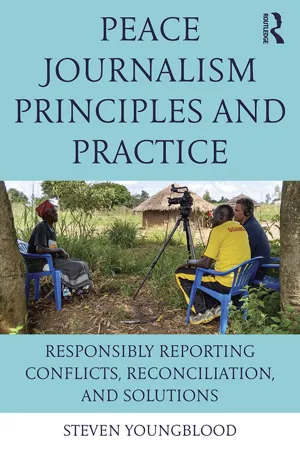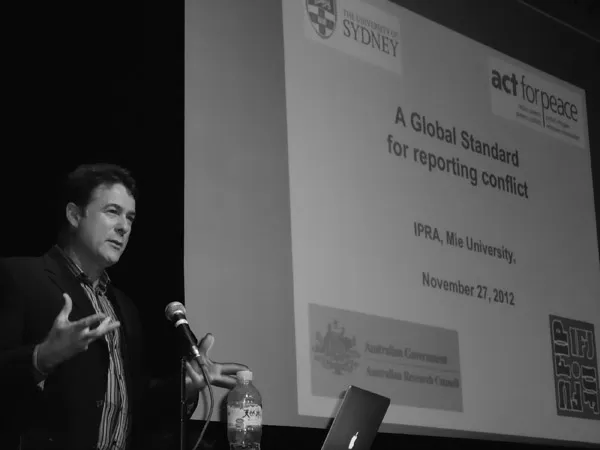![]()
1
The Peace Journalism Approach
Blog: The Power of Peace Media
This Peace Journalism Insights blog was written by Steven Youngblood during a series of peace journalism trainings in Uganda in 2009.
MUNYONYO, UGANDA—As I peered out at the Ugandan radio journalists in my peace journalism class, I came to the stark realization that they are literally in a position to make life and death decisions.
Radio in this part of the world is that important, that influential. The wrong words said the wrong way at the wrong time can, and have, led to violence, even death.
Radio has a singular, awesome power here in Uganda, and throughout much of Africa. For many, radio is the only medium available, since it requires neither electricity nor the ability to read. It doesn’t depend on broken down trucks and rutted roads for delivery. Also, radio is often the only medium that speaks in local ethnic languages.
Sadly, recent history in two countries that border Uganda demonstrates the frightening power of radio stations to manipulate their listeners. In Kenya in 2008, 800 people were killed and 250,000 forced to flee their homes following post-election violence. Hate-filled radio broadcasts played a hand in the mayhem, helping to incite ethnic violence. Even more frightening was the role hate radio played in the 1994 genocide in Rwanda where 800,000 people were killed. Radio Milles Collines has become notorious for its role, which began with hateful speech directed against the Tutsi minority that devolved into thinly veiled references to exterminating “cockroaches.”1
As we discussed hate radio and its potential to ignite violence in Uganda, I asked if radio-incited bloodshed like that which occurred in Kenya and Rwanda could happen here. All the students unhesitatingly answered yes. Why? It could happen here because of the power of radio and the ease of manipulating the populace. One student journalist noted that the most important identity people have in Uganda is ethnic identity, and if they see their people threatened, they would do what is necessary, on the air, to protect their people. Several other students nodded in agreement.
Seizing on the issue of ethnic identity, I led a discussion about what is best for their people. Did any of the ethnic or religious groups benefit from the violence in Kenya or Rwanda? Is Uganda a better place after 20 years of civil war? I emphasized that the best thing journalists can do for their people, and for their country, is to facilitate dialogues about peace and reconciliation, not inflame passions and hatred. Certainly, violence has left no winners here in the Great Lakes region of Africa.
As we closed the emotional discussion, I was encouraged when one student said that “it’s up to us to spread the word” about the power of radio and the awesome responsibility radio journalists here have to use their platform to promote peace and reconciliation instead of hate and violence. All I could think was that the clock is ticking here in Uganda, and that I better teach as many peace journalism seminars as quickly as I can.
Definitions
Any discussion of peace journalism must necessarily begin with a brief examination of this term’s constitutive parts.
Peace has often been defined simply as the lack of conflict or violence. However, one of the fathers of peace studies (and peace journalism), Norwegian academic Dr. Johan Galtung, has written extensively about positive and negative peace. In this construct, Galtung says negative peace is simply the absence of conflict, whereas positive peace consists of conditions where justice, equity, harmony, and so on can flourish.2
For the purposes of peace journalism, Galtung’s notion of positive peace is particularly applicable, since peace journalists strive to spotlight individuals and initiatives that seek these harmonious conditions, and to lead constructive public dialogues about issues that pertain to justice and equity.
The American Press Institute defines journalism as “the activity of gathering, assessing, creating, and presenting news and information.” The Oxford Dictionary says it is: “The activity or profession of writing for newspapers, magazines, or news websites or preparing news to be broadcast.” Of course, this traditional definition has become problematic in the digital age. Does a blogger practice journalism? Are tweets journalism? Is there photojournalism on Instagram? Who is a journalist?
For the purposes of peace journalism, a journalist might be someone who performs the duties listed above and whose work is in some way edited. In addition, a key defining attribute of a peace journalist might be a communicator who considers the consequences of his/her reporting when making journalistic and editorial decisions. In the peace journalism field, one would be less concerned with the nuances of who is technically a journalist and more worried about the content and impact of the messages disseminated by everyone, be they professional journalists, citizen journalists, or social media commentators.
Which Journalism?
Before we move on, we would be wise to acknowledge that the world contains a number of models of journalism—journalisms, or media systems, as they are sometimes called. The book Comparing Media Systems Beyond the Western World (Cambridge University Press, 2012) analyzes disparate media systems, including those based on a national security model (Israel), a cultural model (Baltic states), or a historical model (China), as well as those systems deployed transnationally (trans-Arab media).
It is only in the traditional (Western) construct wherein journalism is perceived ideally as a tool of democracy—an objective watchdog that serves the public interest and not a particular government, policy, corporate or political entity, or agenda. Dr. Jake Lynch, peace journalism’s leading theorist and advocate, writes:
Journalism has long been seen to play a vital role as a civic tool in democracy, but this is now increasingly in question… . The dominant ideology of objective reporting is threatened by upheavals to the structure, conduct and content of journalism, as democratic regimes face a crisis of credibility over their responses to conflicts and crises. The underpinning concepts of journalism need to be renewed, not rejected.3
Lynch is correct about the many upheavals in professional and academic journalism, many of which will be explored in these pages.
While acknowledging the existence of diverse media systems, for the sake of discussion and analysis, in this text, we will use the most familiar (and most heavily researched) Western construct of an idealized, democratic journalism as a basis for our critiques of traditional news media.
Defining Peace Journalism
There are several valid definitions of peace journalism.
Dr. Jake Lynch and Annabel McGoldrick, in their groundbreaking book Peace Journalism, define it as, “when editors and reporters make choices—of what to report, and how to report it—that create opportunities for society at large to consider and value non-violent responses to conflict.”4
Their definition goes on to say that peace journalism (PJ) “uses the insights of conflict analysis and transformation to update the concepts of balance, fairness and accuracy in reporting. It also provides a new road map tracing the connections between journalists, their sources, the stories they cover and the consequences of their journalism, and builds an awareness of nonviolence and creativity into the practical job of everyday editing and reporting.”
Figure 1.1 Professor Jake Lynch presents at the International Peace Research Association in Japan in 2012.
The Center for Global Peace Journalism (Park University) adapts and expands on the Lynch/McGoldrick definition. The center says that PJ is a practice in which “editors and reporters make choices that improve the prospects for peace. These choices, including how to frame stories and carefully choosing which words are used, create an atmosphere conducive to peace and supportive of peace initiatives and peacemakers, without compromising the basic principles of good journalism. Peace Journalism gives peacemakers a voice while making peace initiatives and non-violent solutions more visible and viable.”5
Just as important is a consideration of what peace journalism is not. According to the Center for Global Peace Journalism and Lynch, it is not open advocacy for peace. Instead, PJ is about, in Lynch’s words, “giving peace a chance.”
The Term Peace as Inflammatory
As practitioners and teachers of PJ have observed and written, the word peace itself is ironically inflammatory, stirring strong emotions and conjuring distorted images of 1960s-style long-haired, pot-smoking, tree-hugging hippies. In Peace Journalism, Lynch admits that the term peace journalism doesn’t appeal to everyone, and indeed will be misunderstood as open advocacy for peace and an abandonment of the cherished journalistic notion of objectivity. Lynch wrote that the strength of the term peace journalism lies in its ability to “galvanize, shake up, and send a seismic energy through sedimented layers of (journalistic) tradition, assumption, and definition.”6
Because of the pitfalls of the term peace journalism, some organizations (including International Media Support-Denmark) have instead embraced the term conflict sensitive journalism. Ross Howard writes that conflict sensitive journalists, through unbiased and nonpartisan reporting, can contribute to and enable consensus building. The checklist for conflict sensitive journalism in Howard’s Conflict Sensitive Journalism Handbook aligns almost exactly with similar peace journalism lists. In his checklist, Howard advises journalists to avoid victimizing and emotional language, to avoid making an opinion into a fact, to balance stories, and to report fairly about solutions and peace proposals regardless of the source.7
Dr. Galtung said in an interview that he strongly prefers the concept of peace journalism over conflict sensitive journalism (CSJ). CSJ discusses only one part of the story and only makes the reader aware of the conflict itself, he noted. Dr. Galtung said PJ goes much further, offering trauma sensitivity, empathy, and discussions about equity—a “cooperation for equal benefit,” in his words. Finally, he noted that peace journalism offers analysis about the sources of conflicts and seeks a discussion of a wide range of solutions. Dr. Galtung said journalists should be asking the questions, “Mr. President, what is the conflict underlying the outrageous violence we’re seeing, and Mr. President, what are you going to do to solve this conflict?” (Interview, November 20, 2015).
Therefore, this text uses the term peace journalism because of its broader scope as articulated by Dr. Galtung, because of its ability to “shake things up” according to Lynch, and because of its wide acceptance worldwide by those already practicing this type of reporting. However, understand that many of the ideas and principles discussed here also apply equally to the study and practice of conflict sensitive journalism.
Key Principles
In Peace Journalism, Lynch and McGoldrick lay out a number of principles of peace journalism, including a widely distributed chart comparing peace journalism to “war/violence journalism” and a 17-point checklist of “what a peace journalist would try to do.”
In the chart, war/violence journalism is reporting characterized by us-vs.-them narratives that demonize them, the spreading of propaganda, and reporting that is victory-oriented, reactive, and elite-oriented that focuses only on the visible effects of violence. Peace journalism is the opposite. It is r...

